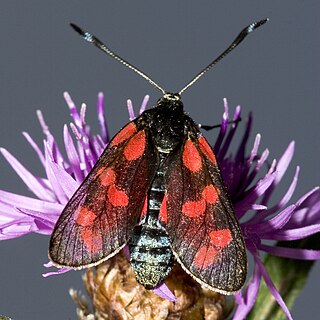
The Zygaenoidea comprise the superfamily of moths that includes burnet moths, forester moths, and relatives.

The Dalceridae are a small family of zygaenoid moths with some 80 known species encompassing about one dozen genera mostly found in the Neotropical region with a few reaching the far south of the Nearctic region.
Dalcerina tijucana is a moth in the family Dalceridae, and the only species in the genus Dalcerina. It was described by Schaus in 1892. It is found in Panama, eastern Peru, Brazil, Paraguay and northern Argentina.
Acraga infusa, the yellow furry-legs, is a moth of the family Dalceridae. It is found in Guatemala, Belize, Costa Rica, Panama, Colombia, Venezuela, Trinidad, Guyana, Suriname, French Guiana, Ecuador, Brazil, Peru, Bolivia and Paraguay.
Acraga boliviana is a moth in the family Dalceridae. It was described by Walter Hopp in 1921. It is found in Bolivia and western Brazil. The habitat consists of subtropical moist forests.
Acraga leberna is a moth in the family Dalceridae. It was described by Druce in 1890. It is found in Panama, Colombia, Venezuela, Guyana, Suriname, French Guiana, Ecuador, northern Brazil, Peru and Bolivia.
Acraga umbrifera is a moth in the family Dalceridae. It was described by Schaus in 1905. It is found in French Guiana. The habitat consists of tropical moist forests.
Acraga victoria is a moth in the family Dalceridae. It was described by S.E. Miller in 1994. It is found in southern Brazil. The habitat consists of warm temperate wet forests.
Dalcerides alba is a moth in the family Dalceridae. It was described by Herbert Druce in 1887. It is found in southern Mexico, Guatemala, Honduras, Belize, Costa Rica, Panama, Colombia and Ecuador.
Dalcerides sofia is a moth in the family Dalceridae. It was described by Harrison Gray Dyar Jr. in 1910. It is found in southern Mexico, Guatemala, El Salvador, Nicaragua and Costa Rica. The habitat consists of tropical moist, tropical dry, tropical premontane wet, subtropical moist, subtropical dry and warm temperate wet forests.
Acraga conda is a moth in the family Dalceridae. It was described by Harrison Gray Dyar Jr. in 1911. It is found in the Guianas.
Dalcerides dulciola is a moth in the family Dalceridae. It was described by Harrison Gray Dyar Jr. in 1914. It is found in southern Mexico, Costa Rica, Panama, northern Ecuador and northern Venezuela. The habitat consists of tropical wet, tropical moist, tropical premontane wet and tropical premontane rain forests.
Dalcerides rebella is a moth in the family Dalceridae. It was described by Schaus in 1911. It is found in Costa Rica and Ecuador. The habitat consists of tropical wet and premontane wet forests.
Dalcerides bicolor is a moth in the family Dalceridae. It was described by Schaus in 1910. It is found in Costa Rica.
Zikanyrops dubiosa is a moth in the family Dalceridae. It was described by Walter Hopp in 1928. It is found in Bolivia.

Dalcera abrasa is a moth in the family Dalceridae. It is found in Colombia, Venezuela, Guyana, Suriname, French Guiana, Brazil, Peru and Bolivia.
Paracraga amianta is a moth in the family Dalceridae. It was described by Harrison Gray Dyar Jr. in 1909. It is found in Guyana. The habitat consists of tropical moist forests.
Paracraga halophora is a moth in the family Dalceridae. It was described by Harrison Gray Dyar Jr. in 1928. It is found in Brazil and southern Peru.
Paracraga argentea is a moth in the family Dalceridae. It was described by Schaus in 1910. It is found in Mexico, Honduras, Belize, Guatemala, El Salvador, Costa Rica and Panama. The habitat consists of tropical wet, tropical moist, tropical premontane wet, tropical premontane moist, subtropical wet subtropical moist forests.
Paracraga canalicula is a moth in the family Dalceridae. It was described by Paul Dognin in 1910. It is found in Colombia and Peru. The habitat consists of tropical wet, tropical moist and tropical premontane wet forests.


